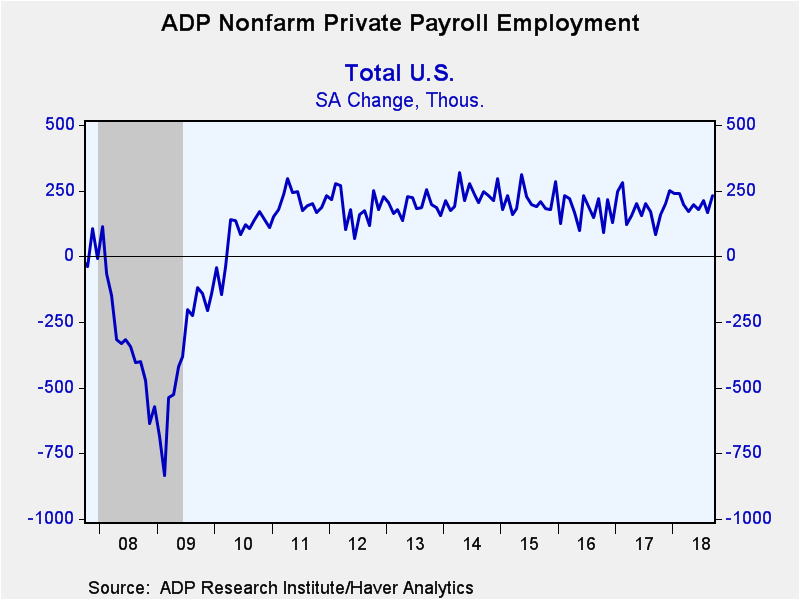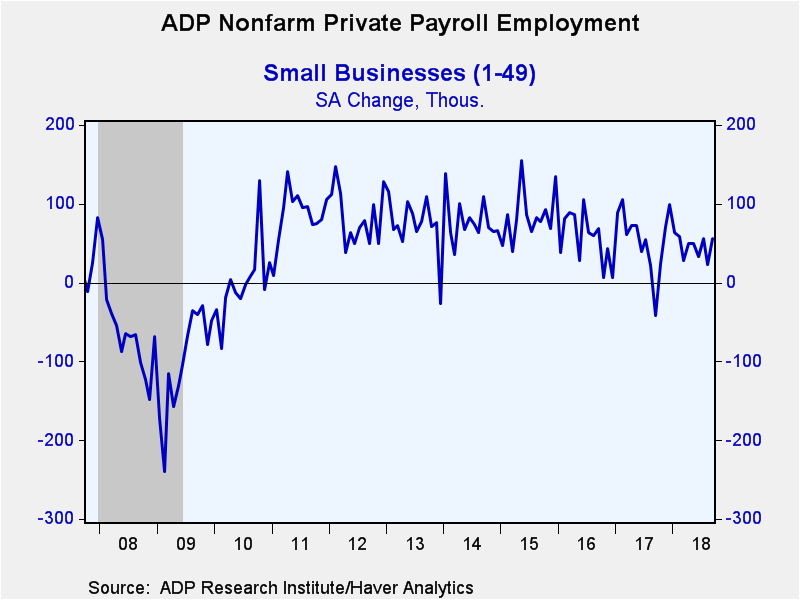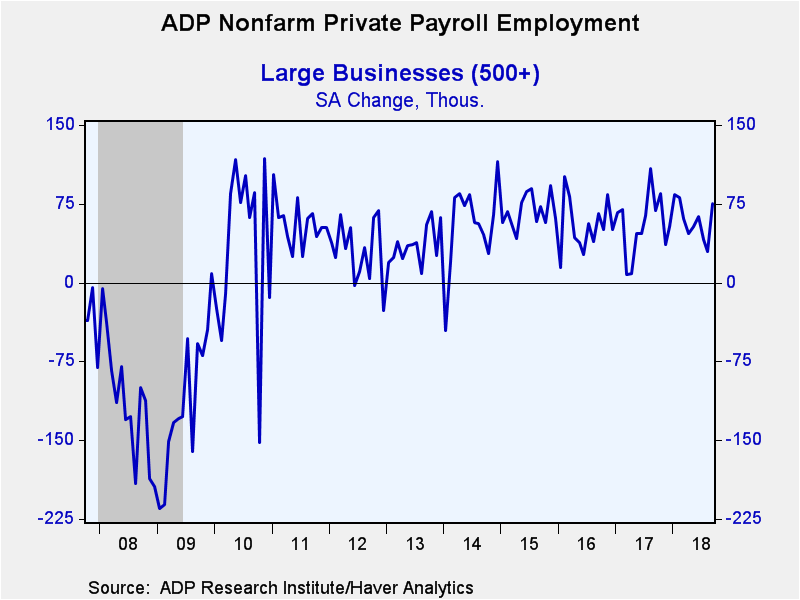 Global| Oct 03 2018
Global| Oct 03 2018Stronger-Than-Expected ADP Private Payrolls
Summary
The ADP National Employment Report indicated that private nonfarm payrolls increased 230,000 (2.0% year-on-year) in September from a slightly upwardly revised 168,000 in August (was 163,000). September's figure handily beat [...]
The ADP National Employment Report indicated that private nonfarm payrolls increased 230,000 (2.0% year-on-year) in September from a slightly upwardly revised 168,000 in August (was 163,000). September's figure handily beat expectations for a 185,000 gain by the Action Economics Forecast Survey. This was the strongest read since February raising the three-month moving average change to 203,000 from the 181,000 average in the second quarter. During the last ten years, there has been a 96% correlation between the change in the ADP figure and the change in nonfarm private-sector payrolls as measured by the Bureau of Labor Statistics.
The ADP National Employment Report is calculated from ADP's business payroll transaction system covering 411,000 companies and nearly 24 million employees. The data is calibrated and aligned with the Bureau of Labor Statistics establishment survey data and is produced by the Automatic Data Processing Research Institute in collaboration Moody's Analytics Inc. The ADP data only cover private sector employment.
Small business payrolls expanded 56,000 (1.2% y/y) in September after 23,000 in August. The three-month average gain of 45,000 was roughly the same as Q2. Medium-sized firms increased 99,000 (2.5% y/y) raising the three-month average to 110,000, the strongest reading in almost four years. Large businesses payrolls improved 75,000 (2.5% y/y) taking the three-month average to 49,000, a touch below Q2's level.
Private service-producing payrolls increased 184,000 (1.9% y/y), the strongest gain since January. Professional & business services jobs rose a four-year high 70,000 (2.8% y/y). Education & health services employment gained 44,000 (2.1% y/y), while the trade, transportation & utilities sector improved 30,000 (1.1% y/y). Employment in the information sector declined 3,000 with payrolls in this sector roughly unchanged for the last three years.
Employment in the goods-producing sector rose 46,000 (2.4% y/y). Factory sector remained payrolls increased just 7,000 (1.7% y/y), the smallest gain since July 2017. Meanwhile construction employment rebounded 34,000 (3.3% y/y) after just 3,000 in August. The natural resource & mining sector improved 5,000 (7.4% y/y). After bottoming out late in 2016, higher oil prices have boosted payrolls by roughly 80,000.
The ADP National Employment Report data can be found in Haver's USECON database; historical figures date back to April 2001 for the total and industry breakdown, and back to January 2005 for the business size breakout. The expectation figure is available in Haver's AS1REPNA database.
| ADP/Moody's National Employment Report | Sep | Aug | Jul | Sep Y/Y | 2017 | 2016 | 2015 |
|---|---|---|---|---|---|---|---|
| Nonfarm Private Payroll Employment (m/m chg, 000s) | 230 | 168 | 211 | 2.0% | 1.8% | 1.9% | 2.3% |
| Small Payroll (1-49) | 56 | 23 | 56 | 1.2 | 1.3 | 1.9 | 1.9 |
| Medium Payroll (50-499) | 99 | 115 | 115 | 2.5 | 1.9 | 1.5 | 2.3 |
| Large Payroll (>500) | 75 | 30 | 41 | 2.5 | 2.3 | 2.7 | 3.0 |
| Goods-Producing | 46 | 23 | 41 | 2.4 | 1.5 | 0.8 | 2.0 |
| Construction | 34 | 3 | 16 | 3.3 | 3.1 | 4.3 | 5.3 |
| Manufacturing | 7 | 19 | 22 | 1.7 | 0.7 | 0.2 | 1.2 |
| Service-Producing | 184 | 145 | 171 | 1.9 | 1.8 | 2.2 | 2.3 |
Gerald D. Cohen
AuthorMore in Author Profile »Gerald Cohen provides strategic vision and leadership of the translational economic research and policy initiatives at the Kenan Institute of Private Enterprise.
He has worked in both the public and private sectors focusing on the intersection between financial markets and economic fundamentals. He was a Senior Economist at Haver Analytics from January 2019 to February 2021. During the Obama Administration Gerald was Deputy Assistant Secretary for Macroeconomic Analysis at the U.S. Department of Treasury where he helped formulate and evaluate the impact of policy proposals on the U.S. economy. Prior to Treasury, he co-managed a global macro fund at Ziff Brothers Investments.
Gerald holds a bachelor’s of science from the Massachusetts Institute of Technology and a Ph.D. in Economics from Harvard University and is a contributing author to 30-Second Money as well as a co-author of Political Cycles and the Macroeconomy.









